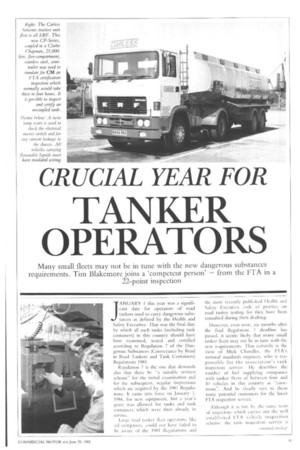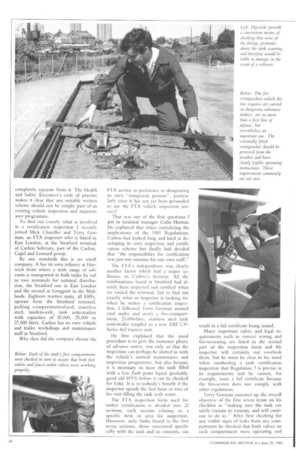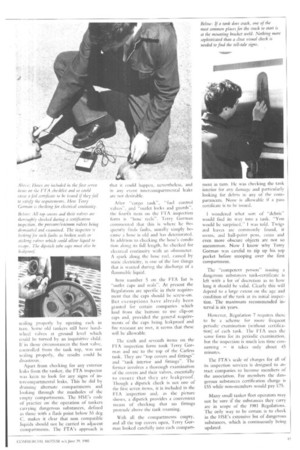CRUCIAL YEAR FOR
Page 43

Page 44

Page 45

If you've noticed an error in this article please click here to report it so we can fix it.
TANKER OPERATORS
Many small fleets may not be in tune with the new dangerous substances requirements. Tim Blakemore joins a 'competent person' — from the FTA in a 22-point inspection
JANUARY 1 this year was a significant date for operators of road tankers used to carry dangerous substances as defined by the Health and Safety Executive. That was the final date by which all such tanks (including tank containers) in this country should have been examined, tested and certified according to Regulation 7 of the Dangerous Substances (Conveyance by Road in Road Tankers and Tank Containers) Regulations 1981.
Regulation 7 is the one that demands also that there be "a suitable written scheme" for the initial examination and for the subsequent, regular inspections which arc required by the 1981 Regulations. It came into force on January 1, 1984, for new equipment, but a year's grace was allowed for tanks and tank containers which were then already in service.
Large road tanker fleet operators, like oil companies. could not have failed to he aware of the 1981 Regulations and the more recently published Ilealth and Safety Executive code of practice on road tanker testing for they have been consulted during their drafting.
I lowevcr, even now, six months after the final Regulation 7 deadline has passed, it seems likely that many small tanker fleets may not be in tune with the new requirements. That certainly is the view of Mick Chandler, the ETA's national standards engineer, who is responsible for the association's tank inspection service. He describes the number of fuel supplying companies with tanker fleets of between four and 10 vehicles in this country as "enormous-. And he clearly sees in them many potential customers for the latest FTA inspection service.
Although it is run by the same ream of inspectors which carries out the well established FTA vehicle inspection scheme, the tank inspection service is completely separate from it. The Health and Safety Executive's code of practice makes it clear that any suitable written scheme should not be simply part of an existing vehicle inspection and maintenance programme.
To find out exactly what is involved in a certification inspection I recently joined Mick Chandler and Terry Gorman, an FTA inspector who is based in East London, at the Stratford terminal of Carless Solvents, part of the Carless, Capel and Leonard group.
By any standards this is no small company. It has its own refinery at Harwich from where a wide range of solvents is transported in bulk tanks by rail to two terminals for national distribution, the Stratford one in East London and the second at Longport in the Midlands. Eighteen tractive units, all ERFs, operate from the Stratford terminal, pulling compartmentalised, stainless steel, tandem-axle, tank semi-trailers with capacities of 20,000, 25,000 or 27,000 litres. Carless has its own vehicle and trailer workshops and maintenance staff at Stratford.
Why then did the company choose the FTA service in preference to designating its own "competent persons", particularly since it has not yet been persuaded to use the FTA vehicle inspection service?
That was one of the first questions I put to terminal manager Colin Horton. He explained that when considering the implications of the 1981 Regulations, Carless had looked long and hard at developing its own inspection and certification scheme but finally had decided that "the responsibility for certification was just too onerous for our own staff."
The FTA's independence was clearly another factor which had a major influence on Carless's decision. All the combinations based at Stratford had already been inspected and certified when we visited the terminal, but to find out exactly what an inspector is looking for when he makes a certification inspection, I followed "Ferry Gorman around (and under and over) a five-compartment, 25,000-litre, stainless steel tank semi-trailer coupled to a new ERF CPSeries 4x2 tractive unit.
He first explained that the usual procedure is to give the customer plenty of advance notice, not only so that the inspection can perhaps be slotted in with the vehicle's normal maintenance and inspection programme, but also because it is necessary to have the tank filled with a low flash point liquid (probably good old H20) before it can be checked for leaks. It is to nobody's benefit if the inspector spends the first hour or two of his visit filling the tank with water.
The FTA inspection form used for tanker certification is divided into 22 sections, each section relating to a specific item or area for inspection. However, only faults found in the first seven sections, those concerned specifically with the tank and its contents, can result in a fail certificate being issued.
Many important safety and legal requirements such as correct wiring and fire-screening arc listed in the second part of the inspection form and the inspector will certainly not overlook them, but he must be clear in his mind when conducting a tank certification inspection that Regulation 7 is precise in its requirements and he cannot, for example, issue a fail certificate because the fire-screen does not comply with other regulations.
Terry Gorman summed up the overall objective of the first seven items on his checklist as "making sure the tank can safely contain its conents, and will continue to do so." After first checking for any visible signs of leaks from any compartment he checked that both valves on each compartment were operating and
sealing properly by opening each in turn. Some old tankers still have handwheel valves at ground level which could he turned by an inquisitive child. If in those circumstances the foot valve, controlled from the tank top, was not sealing properly, the results could be disastrous.
Apart from checking for any exterior leaks from the tanker, the PTA inspector was keen to look for any signs of intercompartmental leaks. This he did by draining alternate compartments and looking through the manholes of the empty compartments. The HSE's code of practice on the operation of tankers carrying dangerous substances, defined as those with a flash point below 55 deg C. makes it clear that non compatible liquids should not be carried in adjacent compartments. The PTA's approach is
that it could happen, nevertheless, and in any event intercompartmental leaks are not desirable.
After -cargo tank", "fuel control valves', and "outlet locks and guards", the fourth item on the FTA inspection form is "hose reels". Terry Gorman commented that this is where he frequently finds faults, usually simply because a hose is old and has deteriorated. In addition to checking the hose's condition along its full length, he checked for electrical continuity with an ohmmeter. A spark along the hose reel, caused by static electricity, is one of the last things that is wanted during the discharge of a flammable liquid.
Item number 5 on the FrA list is "outlet caps and seals". At present the Regulations are specific in their requirement that the caps should be screw-on. But exemptions have already been granted for certain companies which load from the bottom to use clip-on caps and, provided the general requirements of the caps being leakproof and fire resistant are met, it seems that these will be allowable.
The sixth and seventh items on the FIA inspection form took 'Ferry Gorman and me to the top of the Carless tank. They are "top covers and fittings" and "tank interior and fittings". The former involves a thorough examination of the covers and their valves, essentially to ensure that they are leakproof.
Though a dipstick check is not one of the first seven items, it is included in the FTA inspection and, as the picture shows, a dipstick provides a convenient means of checking that no fittings protrude above the tank coaming.
With all the compartments empty, and all the top covers open, Terry Gorman looked carefully into each comport
ment in turn. He was checking the tank interior for any damage and particularly looking for debris in any of the compartments. None is allowable if a pass certificate is to he issued.
I wondered what sort of "debris" would find its way into a tank. "You would be surprised," I was told. Twigs and leaves are commonly found, it seems, and ball-point pens, coins and even more obscure objects are not so uncommon. Now I know why Terry Gorman was careful to zip up his top pocket before stooping over the first compartment.
The "competent person" issuing a dangerous substances tank-certificate is left with a lot of discretion as to how long it should he valid. Clearly this will depend to a large extent on the age and condition of the tank at its initial inspection. The maximum recommended interval is six years.
However, Regulation 7 requires there to be a scheme for more frequent periodic examination (without certification) of each tank. The FTA uses the same form for its periodic examination, but the inspection is much less time consuming — it takes only about 45 minutes.
The PTA's scale of charges for all of its inspection services is designed to attract companies to become members of the association. For members the dangerous substances certification charge is ,E55 while non-members would pay .05.
Many small tanker fleet operators may not be sure if the substances they carry are in scope of the 1981 Regulations. The only way to be certain is to check in the FISE's extensive list of dangerous substances, which is continuously being updated.




































































































